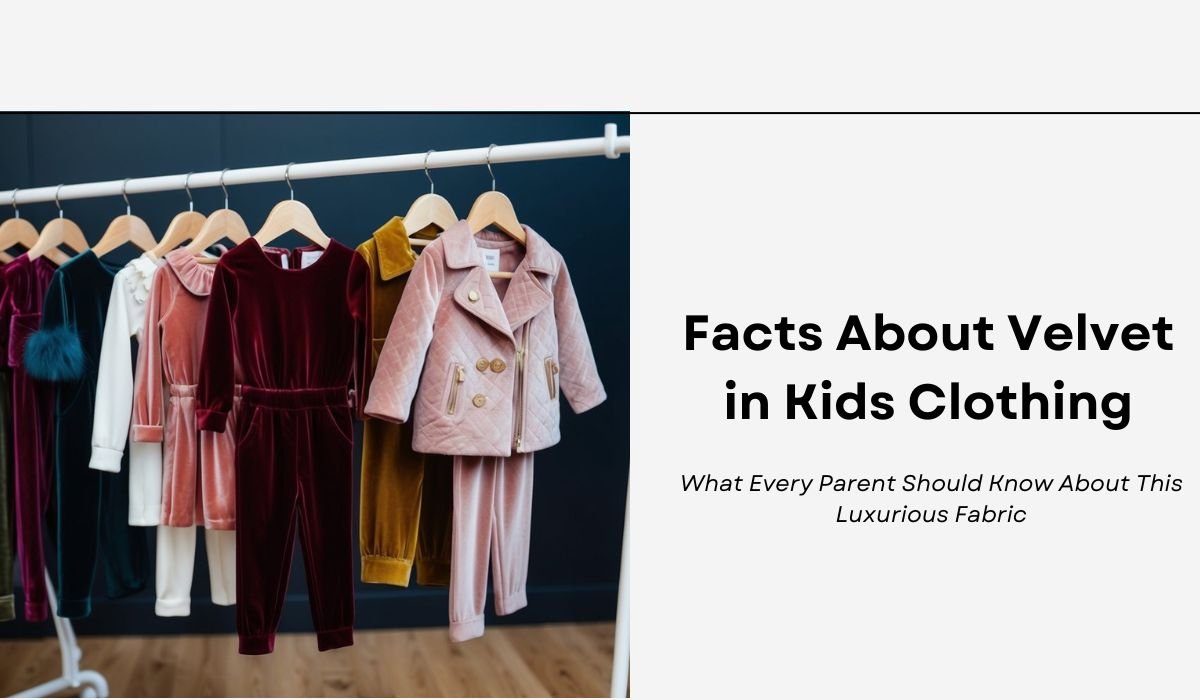From Party Dresses to Special Occasions: A Parent’s Guide to Choosing and Maintaining Children’s Velvet Garments
Velvet has been a cherished fabric in children’s fashion for generations. This luxurious material brings warmth and elegance to kids’ clothing, making it a popular choice for special occasions like parties, holidays, and formal events. Velvet’s distinctly smooth feel comes from its unique weaving process that creates an evenly distributed pile of threads.
From cosy winter dresses to smart holiday suits, velvet adds a touch of sophistication to children’s wardrobes. The fabric’s rich texture makes it especially suited for festive attire, while its durability ensures these special pieces can be passed down through siblings or preserved as cherished mementoes.
On This Page
Key Takeaways
- Velvet garments require specific care methods to maintain their plush texture and appearance
- Modern velvet production includes both traditional and innovative sustainable practices
- The fabric’s versatility makes it suitable for various children’s clothing styles throughout the year
The History of Velvet in Fashion
Velvet’s journey through time spans thousands of years, starting in ancient civilisations and transforming from a textile reserved for royalty to a fabric enjoyed by people worldwide. The production methods and cultural significance of velvet shaped fashion across continents.
Ancient Origins and Global Journey
Velvet production began in ancient civilisations, with skilled craftsmen in China and India developing early weaving techniques. The fabric made its way along the Silk Road to Medieval Kashmir, where artisans perfected the art of velvet weaving.
The trade routes between Asia and Europe brought velvet to Mediterranean ports, particularly Genoa. Italian weavers became renowned for their mastery of velvet production.
Chinese velvet makers guarded their techniques carefully, creating unique patterns and textures that became highly sought after in international markets.
Velvet’s Role in European Nobility
Velvet became a symbol of wealth and power in European courts. King Richard II of England even demanded his burial robes be made of velvet.
Royal families across Europe wore velvet garments adorned with precious metals and jewels. The most prestigious velvet came from Italian city-states, where craftsmen created elaborate patterns.
European artistic velvets featured complex designs incorporating gold and silver threads. These pieces often took months to complete and cost enormous sums.
The Evolution During Industrialisation
The Industrial Revolution brought significant changes to velvet production. New machinery made it possible to create velvet from various fibres, including cotton and wool, not just silk.
Mass production techniques developed during World War II made velvet more accessible to the general public. Synthetic fibres revolutionised the industry, creating more affordable options.
Modern velvet maintains its luxurious appeal while being more versatile and durable than its historical counterparts. Fashion designers regularly feature velvet in their collections, especially for formal wear and winter fashion.
Understanding Velvet and Its Production
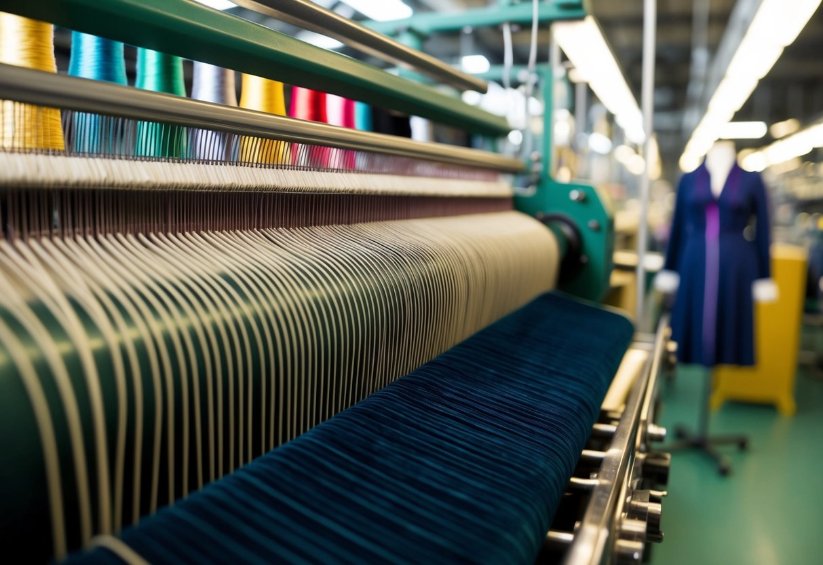
Velvet fabric is a unique textile made with special weaving methods that create its signature soft, plush surface. The production process involves complex machinery and careful attention to detail to achieve the luxurious feel that makes velvet special.
Basic Composition of Velvet
Velvet’s distinctive texture comes from its woven tufted structure. The fabric has two main parts: a base layer and standing fibres that create the soft pile.
The pile gives velvet its smooth feel. These upright threads are evenly spaced and typically very short, creating a dense surface that feels soft to touch.
Manufacturing velvet requires a unique process where two pieces are woven at the same time. These pieces are then cut apart, creating the characteristic pile on each piece.
Different Fibres and Weaving Techniques
Velvet can be made from many different materials:
- Natural fibres: Silk, cotton, wool
- Synthetic fibres: Polyester, nylon, rayon
- Blended materials: Mix of natural and synthetic
Special looms create velvet’s distinctive texture. These machines weave two layers simultaneously, connecting them with extra yarn that forms the pile when cut.
Modern techniques have created new varieties like stretch velvet, which includes elastic fibres for better movement and comfort.
Industrial Revolution and Mass Production
The Industrial Revolution brought significant changes to velvet production. New machinery made the process faster and more efficient.
Modern factories use computerised looms to create velvet. These machines can produce large amounts of fabric quickly while maintaining high quality.
Today’s production methods allow for different pile heights and patterns. Manufacturers can create various textures and effects to suit different clothing styles.
Types of Velvet Used in Children’s Clothing
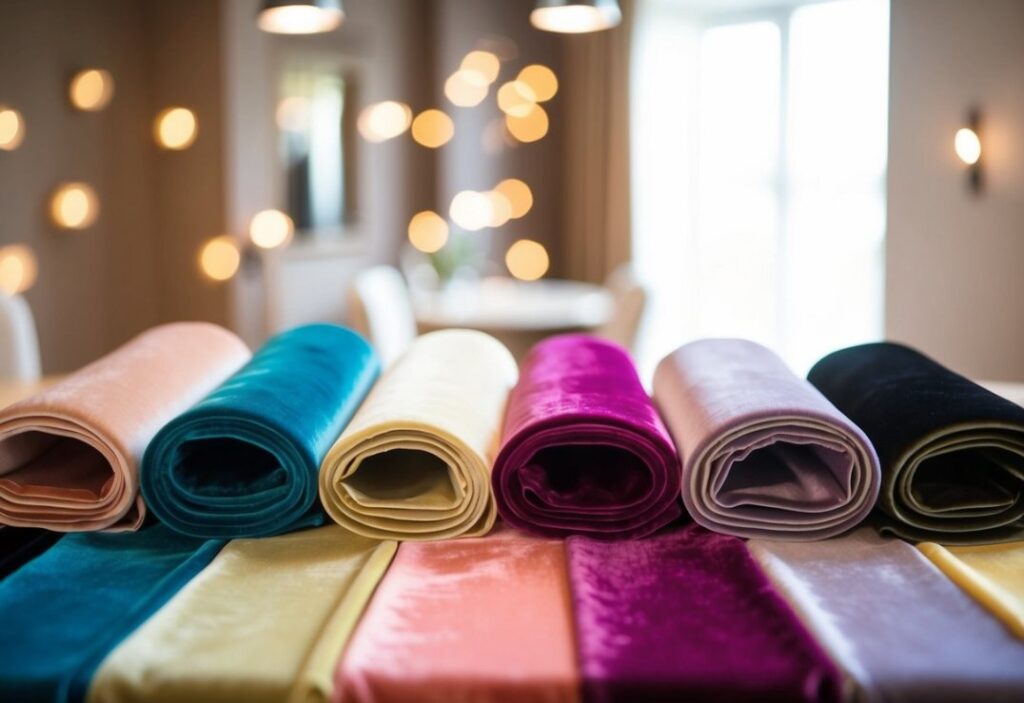
Different velvet fabrics offer unique properties that make them suitable for children’s clothing. Some types focus on durability and easy care, whilst others provide luxurious comfort and elegant appearance.
Silk Velvet and Luxury Variants
Pure silk velvet creates an exceptionally soft and smooth surface that’s perfect for special occasion clothing. Its natural sheen makes it ideal for formal dresses and holiday outfits.
Crushed velvet, made by twisting the fabric whilst wet, creates interesting light-catching patterns. This type is popular for party dresses and festive wear.
Embossed velvet features raised patterns pressed into the fabric. These designs range from simple dots to elaborate floral motifs, making them exciting choices for special events.
Velveteen and Cotton-Based Velvets
Cotton velveteen provides excellent durability for everyday children’s wear. It’s easier to clean than silk varieties and maintains its appearance after multiple washes.
Cotton-based velvets work well for winter clothing like jackets and dresses. The dense pile helps keep children warm whilst remaining breathable.
These fabrics resist crushing better than silk versions, making them practical for active children.
Innovations in Synthetic Velvet
Stretch velvet with spandex offers excellent movement for dance costumes and athletic wear. It’s particularly useful for gymnastics leotards and performance outfits.
Modern polyester velvets provide stain resistance and easy care properties. These qualities make them practical choices for school clothes and everyday wear.
Microfibre velvet combines durability with a silk-like feel. It’s becoming increasingly popular for children’s special occasion clothing that needs to withstand active wear.
The Significance of Velvet in Kids’ Fashion
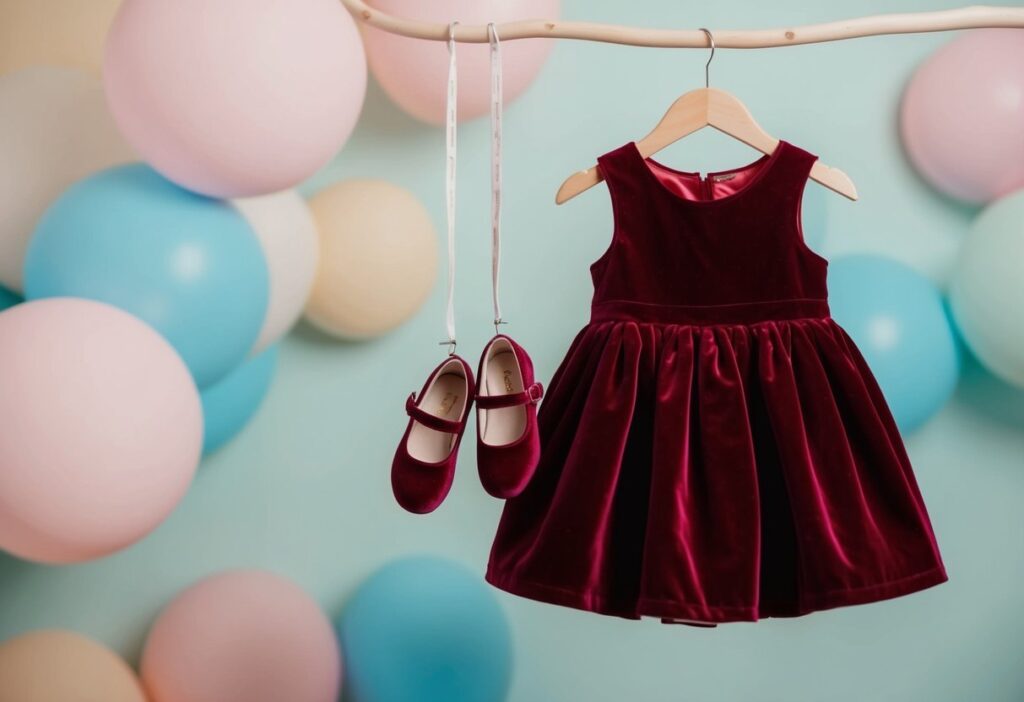
Velvet fabric in children’s clothing adds elegance and comfort to special occasion wear. Its distinct texture and rich appearance make it a favourite choice for parents seeking sophisticated options for their children.
Velvet as a Symbol of Luxury and Style
Velvet has long represented refinement in children’s fashion. Its cultural significance in fashion dates back centuries, when the material symbolised wealth and social status.
The smooth, luxurious feel of velvet makes children feel special when wearing it. The fabric’s plush texture and subtle sheen elevate simple garment designs into elegant pieces.
Many high-end children’s fashion houses regularly feature velvet in their collections. The material’s association with luxury makes it particularly popular for special events and formal occasions.
Popular Velvet Items in Kids’ Wardrobes
Common velvet pieces for children include:
- Party dresses with full skirts
- Smart blazers and waistcoats
- Holiday-themed outfits
- Special occasion shoes
- Hair accessories and headbands
Winter celebrations see a surge in velvet clothing sales. The fabric’s warmth and cosiness make it ideal for festive gatherings and formal winter events.
Velvet dresses remain the most sought-after items, especially in deep jewel tones like burgundy and navy. Many feature details like peter pan collars or ribbon sashes to enhance their charm.
Practical Considerations for Velvet in Children’s Clothing
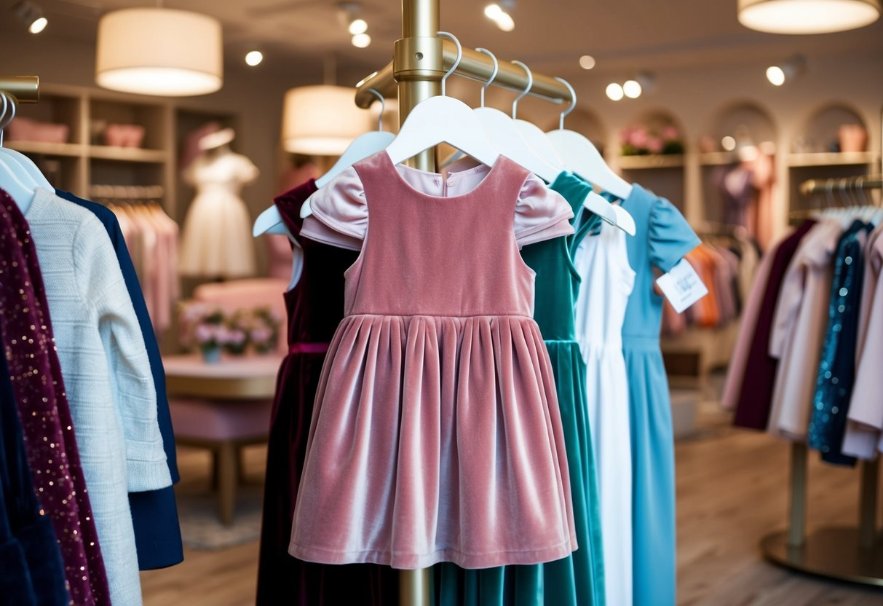
Velvet garments require specific care and attention to maintain their luxurious appearance. Parents need to balance the fabric’s beauty with practical aspects of children’s daily activities and environmental responsibility.
Maintenance and Durability
Velvet fabric requires special care to keep its distinctive pile and soft texture. Regular gentle brushing helps maintain the pile direction and prevents crushing.
Most velvet garments need professional dry cleaning to avoid damage. Some modern varieties can be hand washed, but the care label should always be checked first.
Proper storage is essential. Hanging velvet items with space between them prevents the pile from becoming flattened. Avoid folding velvet clothes, as creases can be difficult to remove.
The fabric can show wear patterns in high-friction areas like elbows and knees. Rotating velvet items in a child’s wardrobe helps distribute wear more evenly.
Comfort and Suitability for Children
Different types of velvet offer varying levels of comfort. Cotton velvet provides excellent breathability and suits sensitive skin.
Synthetic velvet blends often resist wrinkles better than pure natural fibres. These blends maintain their shape during active play.
The weight of velvet makes it ideal for autumn and winter wear. Light varieties work well for special occasions year-round.
The fabric’s natural stretch allows freedom of movement, essential for growing children.
Environmental Considerations and Sustainable Practices
Traditional velvet production uses significant resources. Modern manufacturing methods have reduced water and energy consumption.
Choosing organic cotton or recycled fibre velvet reduces environmental impact. These options often cost more but last longer with proper care.
Many manufacturers now create velvet from recycled plastic bottles. This innovation helps reduce waste while maintaining the fabric’s luxurious feel.
Buying quality velvet pieces that can be passed down to siblings or other children extends the garment’s lifecycle.
The Role of Velvet in Kids’ Special Occasion Wear
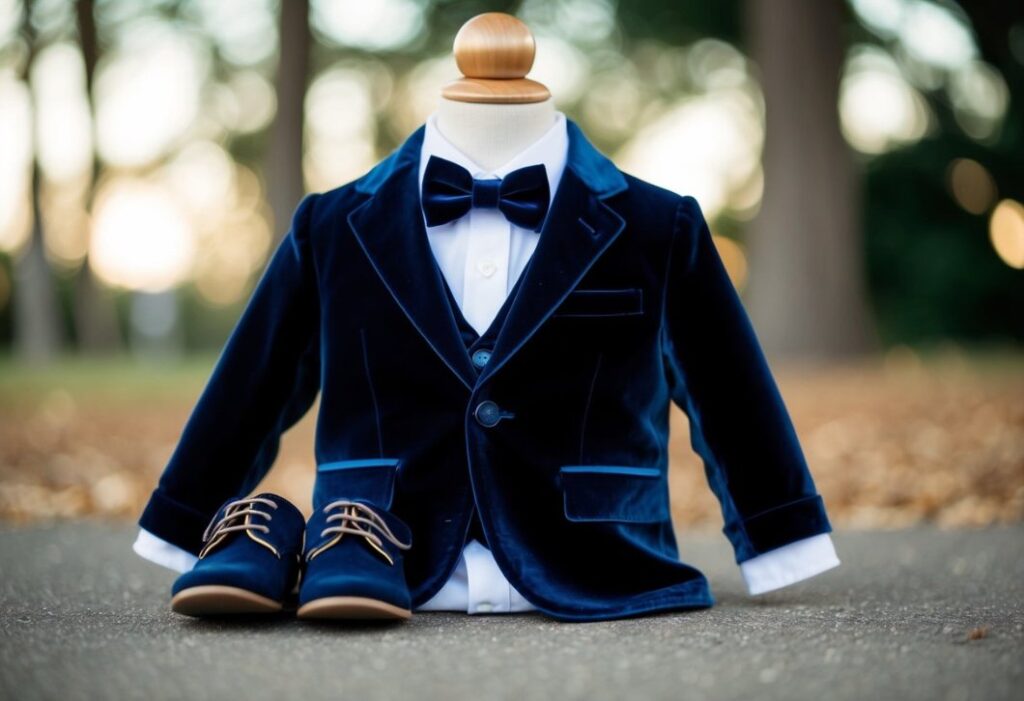
Velvet fabric adds elegance and sophistication to children’s formal wear with its smooth texture and rich appearance. Its luxurious feel makes it a top choice for parents seeking premium clothing for memorable events.
Weddings and Formal Events
Girls’ velvet dresses are a classic choice for flower girls and young wedding guests. The fabric’s natural sheen catches light beautifully in wedding photographs.
Deep jewel tones like navy and burgundy work brilliantly for boys’ velvet blazers and waistcoats. These pieces pair smartly with formal trousers.
Popular velvet accessories include:
- Hair bows and headbands
- Smart bow ties
- Mary Jane shoes
- Small pouches and purses
Holiday Season and Party Attire
Winter celebrations call for cosy yet stylish velvet outfits. Red and green velvet dresses remain favourite choices for Christmas parties and family gatherings.
Boys look dapper in velvet suits with satin lapels for New Year’s celebrations. The fabric keeps children warm whilst maintaining a festive appearance.
Essential holiday velvet pieces:
- Party dresses with peter pan collars
- Decorative sashes and belts
- Smart velvet blazers
- Festive hair accessories
Velvet party clothes often feature special details like embroidery or beading to enhance their celebratory feel.
Caring for Velvet Clothing: Tips and Tricks
Velvet requires specific care techniques to maintain its luxurious pile and prevent damage. Proper maintenance and storage keeps velvet garments looking their best, whilst professional cleaning addresses deeper issues.
Regular Maintenance and Storage
The tactile nature of velvet makes it sensitive to daily wear. Never fold velvet clothing – always hang it on padded hangers to prevent creasing.
Use a soft-bristled brush to gently sweep the pile in one direction after each wear. This prevents matting and maintains the fabric’s signature sheen.
Store velvet items in breathable garment bags, away from direct sunlight. Leave space between garments to prevent crushing the pile.
For minor wrinkles, hang the garment in a steamy bathroom. Never iron velvet directly – this can permanently flatten the pile.
Professional Cleaning and Special Care
Professional cleaning is essential for maintaining velvet’s appearance. Always check the care label – most velvet items require dry cleaning.
For small spills:
- Blot immediately with a clean, dry cloth
- Never rub the fabric
- Avoid using water or cleaning solutions
Synthetic velvets may be more durable, but still need gentle care. Check the manufacturer’s instructions before attempting any home cleaning methods.
Professional cleaners use specialised techniques to address stains without damaging the pile. They can also restore crushed areas and maintain the fabric’s texture.
Ethical and Sustainable Practices in Velvet Production
The textile industry has made significant progress in producing velvet through eco-friendly methods and responsible manufacturing. Modern techniques focus on reducing waste and protecting worker wellbeing.
Reducing Environmental Footprint
Natural velvet fabrics made from organic cotton and plant-based materials create less pollution compared to synthetic options. These materials break down naturally at the end of their lifecycle.
Many manufacturers now use closed-loop water systems to recycle water during production. This process helps save thousands of litres of water each year.
Eco-conscious velvet producers have switched to renewable energy sources like solar and wind power. These changes reduce carbon emissions from factory operations.
Advancements in Ethical Manufacturing
Fair labour practices ensure workers receive proper wages and safe working conditions. Regular factory audits help maintain these standards.
Modern velvet production facilities use automated systems to protect workers from harmful chemicals and dust particles. Proper ventilation and safety equipment are now standard requirements.
Transparent supply chains allow parents to trace where their children’s velvet clothing comes from. This helps ensure the materials meet safety and ethical standards.
Companies now offer training programmes to help workers develop new skills. These initiatives support local communities and improve working conditions.
Frequently Asked Questions
Velvet garments require specific production methods and care instructions to maintain their luxurious feel. Parents often have questions about durability, cleaning, and sustainability when choosing velvet clothing for their children.
What are the distinctive characteristics of velvet fabric used in children’s clothing?
Velvet fabric has a distinctive smooth feel created by evenly distributed cut threads forming a short, dense pile. The plush texture provides warmth and comfort for children’s garments.
The fabric’s unique construction creates a rich appearance with depth and lustre. When light hits velvet, it produces a shimmering effect that changes as the fabric moves.
How is velvet material produced for apparel, particularly kids’ garments?
Special looms weave two pieces of velvet simultaneously. The process creates two identical pieces that are cut apart and rolled separately.
Modern velvet production uses various fibres, including cotton, silk, and synthetic materials. Each fibre type offers different benefits for children’s clothing.
Can you list several applications of velvet in the textile industry, including childrenswear?
Velvet appears in special occasion dresses, winter coats, and holiday outfits for children. The fabric adds elegance to formal wear and warmth to seasonal clothing.
Designers use velvet for accessories like hair bows, shoes, and bags. The material works well for both decorative and functional pieces.
What are the benefits of using velvet fabric for children’s clothing?
Velvet provides excellent insulation during cold weather. The raised pile traps air, creating natural warmth without excessive bulk.
The soft texture feels gentle against children’s sensitive skin. Quality velvet resists crushing and maintains its appearance with proper care.
Are there any ethical or sustainability issues associated with the production of velvet for clothing?
Synthetic velvet production requires significant energy and chemical processes. Some manufacturers now use recycled materials to create more eco-friendly options.
Water consumption in velvet manufacturing presents environmental challenges. Ethical producers implement water recycling systems and sustainable practices.
What care instructions are recommended for maintaining the quality of kids’ velvet garments?
Gentle hand washing or professional dry cleaning helps preserve velvet’s pile. Always check garment labels for specific cleaning instructions.
Store velvet items hanging or lying flat to prevent crushing. Use a soft brush to restore the pile’s direction after wearing.
Related Posts:

